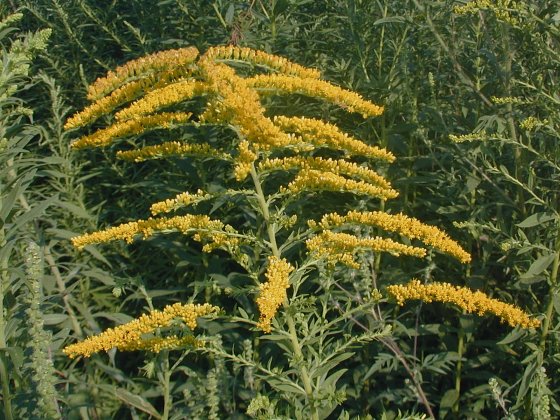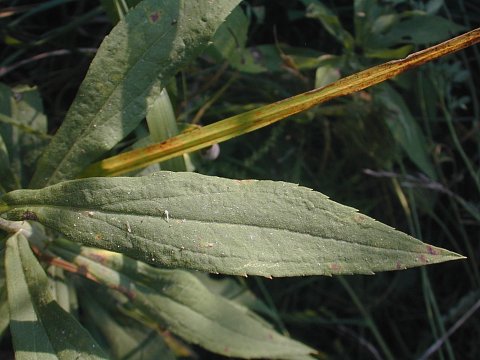Description: This is a herbaceous perennial plant with a central stem that is 2-6' tall. Because of the wide distribution and the existence of several varieties, there is significant variability in the characteristics of local ecotypes. The alternate leaves are about 4-6" long and 1" wide, becoming slightly smaller towards the apex of the plant. They are lanceolate to broadly linear in shape, and usually have small teeth along the margins, otherwise the margins are smooth. The stems have lines of white hairs, while the undersides of the leaves are pubescent.

Several flowering stems emerge from the top of the plant in the form of a panicle bearing masses of tiny yellow flowers in compact heads. Each flowerhead is less than ¼" across. The flowerhead occur along the upper part of each flowering stem, and sometimes have a slight fragrance. The blooming period is from late summer to fall; individual plants typically remain in bloom about 3 weeks. The achenes are longitudinally ribbed, slightly hairy, and have small tufts of hair, which help to provide dispersion by wind. The root system is fibrous, producing creeping rhizomes that cause the plants to cluster, sometimes forming dense colonies.

Cultivation:
The
preference is full to partial sun, and average moisture levels. This
plant will tolerate some drought, in which case it will probably drop
some of its lower leaves. This plant tolerates a variety of soils,
perhaps even preferring a heavier soil with some clay content. During
the fall, powdery mildew occasionally attacks the leaves.
Range & Habitat:
The native Canada Goldenrod occurs in almost all of the counties in
Illinois and it
is very common (see Distribution
Map). Natural habitats include disturbed areas of moist to
dry prairies, openings in both floodplain and upland forests, thickets,
savannas, limestone glades, and gravel seeps. In more developed areas,
it occurs in both cultivated and abandoned fields, vacant lots,
power-line clearance areas, and along fences, roadsides, and railroads.

Faunal Associations: A wide variety of insects visit the flowers for pollen or nectar, including long-tongued bees, short-tongued bees, wasps, flies, beetles, and a few butterflies and moths. Cross-pollination by these insects is required in order to set fertile seeds. The caterpillars of many moths feed on the foliage and other parts of this goldenrod and others (see Moth Table). A common insect that forms spherical galls on the stems is Eurosta solidaginis (Goldenrod Gall Fly). Other insects that feed on this goldenrod include Epicauta pensylvanica (Black Blister Beetle), Lopidea media (Goldenrod Scarlet Plant Bug), Lygus lineolaris (Tarnished Plant Bug), and various leaf beetles and leafhoppers. Among mammals and birds, the Prairie Chicken, Eastern Goldfinch, and Swamp Sparrow eat the seeds, while the White-Tailed Deer and Eastern Cottontail Rabbit occasionally eat the foliage (although it is not a preferred food source). In overgrazed pastures, there have been reports of a rust fungus on the leaves of goldenrod poisoning livestock during the fall. Sometimes beavers and muskrats use the stems in their dams or dens.

Photographic
Location:
The photographs were taken in a vacant lot along a railroad in Urbana,
Illinois.
Comments:
This is the most common and weedy goldenrod in Illinois. The flowers
are especially attractive to many species of wasps and flies, which
play an important role in controlling insect pests, or breaking down
organic matter in the detritus cycle. The species Solidago
altissima (Tall Goldenrod) is considered a variety of Canada
Goldenrod by some authorities, while others (e.g., Mohlenbrock, 2002)
treat it as a separate species. According to the latter authority, Tall
Goldenrod has longer phyllaries (floral bracts) at the base of its
flowerheads (exceeding 3 mm. in length), while Canada Goldenrod has
shorter phyllaries (3 mm. or less). It has been reported that the
foliage of Canada Goldenrod contains a volatile oil that chemically
resembles the oil from pine needles. There is also some experimental
evidence that this species inhibits the growth of maple seedlings, and
probably other plants as well, by exuding phytotoxic chemicals through
its roots.